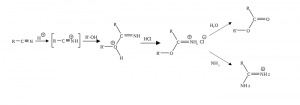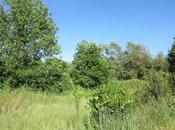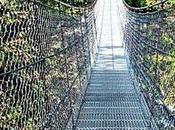
I really don't get it. Really.
No, non sono arrabbiata con nessuno. Anzi. Ho recentemente scoperto che un mio parente lontano e tedesco era un chimico – ecco spiegata l’innata vena chimica di mia sorella!
Questo tale Adolf Pinner – sì, le ovvie battute tenetevele per voi, che le ho già fatte io – era un chimico così bravo che ha scoperto una reazione nuova. Nuova a quell’epoca, ovviamente. E ha dato il suo cognome a questa reazione (Reazione di Pinner), così anche io ho una reazione con il mio nome – o meglio, con il cognome del mio nickname, ma ormai anche mia madre mi chiama ‘Pinnera’.
Ora vi spiegherò in poche parole questa reazione, e come al solito ve la spiego a modo mio:
- Una reazione si crea così: reagente + reagente = prodotto. Il prodotto è un sale, chiamato Sale di Pinner, non a caso.
- Il reagente numero 1 è un nitrile, ossia una specie di composto organico formato da carbonio e azoto, legati tra loro da un triplo legame.
- Il reagente numero 2 è un alcol. Non quello per disinfettare, nemmeno quello del vino o della birra. É un altro alcol, ma non chiedetemi quale, perché non lo so.
- Per fare in modo che queste due cose reagiscano, ci vuole un reagente. In questo caso il catalizzatore (perché si chiama così) è l’acido cloridrico, una delle cose più tossiche del pianeta. Di certo con il Sale di Pinner non ci si cucina la pasta.
- L’acido cloridrico si unisce al nitrile e all’alcol: favorisce la reazione dei due reagenti e la accelera, rompendo i legami e creandone degli altri, quelli del sale.
A cosa serve questo sale, io non lo so. Non lo sa nemmeno Wikipedia. Se qualcuno lo sa, me lo dica!
Ora che ho una reazione chimica tutta mia, ho segnato il mio prossimo traguardo: andare nel borough di Pinner, Londra. Speriamo di riuscirci!
–
No, I am not angry with anyone. Indeed. I recently discovered that a distant relative of mine was a German chemist – thus explaining the innate chemical vein of my sister!
This Adolf Pinner – yes, keep the obvious jokes for you, I’ve already made them - was a chemist so skilled that he discovered a new reaction. New at that time, of course. And he gave his name to this reaction (Pinner Reaction), so I have a reaction with my name – or rather, with the last name of my nickname, but actually even my mother uses to call me ‘Pinnera’.
Now I will explain this reaction in a nutshell, and as usual I explain it in my own way, so don’t take your notebooks.
- A reaction is created as follows: reactant + reactant = product. The product is a salt called Pinner Salt not by chance.
- The reagent number 1 is a nitrile, ie a kind of organic compound consisting of carbon and nitrogen, bound together by a triple bond.
- The reagent number 2 is an alcohol. Not the one to disinfect, not the wine or the beer one. It is another alcohol, but don’t ask me more because I do not know.
- To make sure that these two things react, we need a reagent. In this case the catalyst (this is its technical name) is an hydrochloric acid, one of the most toxic things of the planet. I can’t definitely cook pasta using Pinner Salt.
- The hydrochloric acid joins the nitrile and the alcohol: it promotes the reaction of two reactants by accelerating, breaking and creating different bonds, those of the salt.
What this salt is used for, I really don’t know. Even Wikipedia doesn’t know it. If someone knows it, just give a call – or a comment as well!
Now that I have my own chemical reaction, I’m going to set my next goal: going to the borough of Pinner, London. Hopefully!






